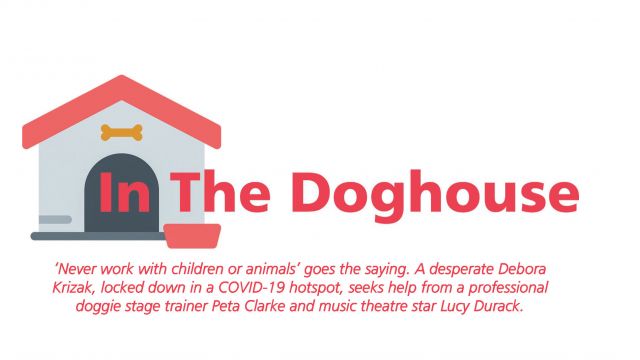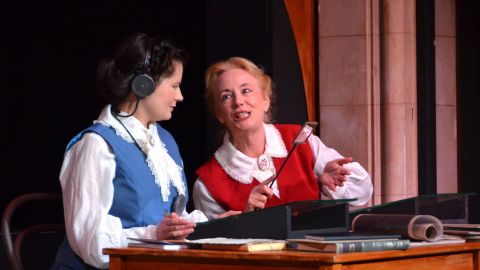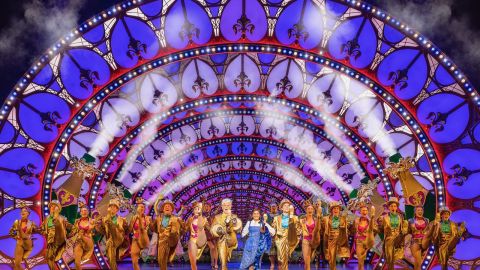In The Doghouse

Please know, today was a good day, even though I don’t know what day it is anymore. It doesn’t matter apparently. Not until we reach 80%. It’s almost 11am and a flutter of excitement comes over me as I switch on the tele in anticipation of the daily press conference. For a split second, it feels like opening night nerves but then my mind catches up and I realize I’m still in my PJ’s, slurping unapologetically on my cup of instant coffee.
I’ve been thinking long and hard about my ‘Behind the Scenes’ feature this month but it seems somewhat futile to spotlight the fabulous work being done by my peers when, let’s face it - the lights are off and nobody’s everybody’s home. So, I’m coming to you live from my locked down LGA in Sydney where Gladys has finally closed Bunnings and every parent in lock down grapples with the reality that home schooling is like being trapped in an episode of Survivor.
It’s time for PE and the twins have been instructed to do something “physical”. They both look pale and unengaged so when they plead with me to do the latest Gladys workout posted on Tik Tok, who am I to say no? I can’t sugar coat this whole fiasco any longer. If they want to attempt a burpee every time Gladys repeats herself, they can knock themselves out. While they’re at it, they can knock me out too and wake me up when we’re at 70% - just so I have enough time to primp and preen myself before we reach that magic 80% and are released back into the wild.
In the meantime, I’ve been lured into the online world of puppy scams. The kids thought we should utilize our time in lockdown to get a puppy. Feeling sorry for them, I start browsing the net. This proves to be a welcome distraction from arguments with anti-vaxxers on Facebook who claim that Ivermectin is the cure for Covid. Lockdown brings out the worst in us all - especially the scammers - but like all the anti-vaxxers, they underestimate the power of proven research. I digress…
We welcome our new puppy “LuLu” into home detention, and I suddenly remember what it is like to be locked up with a destructive toddler. Nothing is off limits and I have unwittingly become the sole carer of a weeing, pooing, chewing ball of brown chocolate fluff. Luckily, I have nothing else to do – thanks Gladys. The cuteness factor lasted an entire day for the kids until LuLu decided that bedspreads and pillows were the ideal place to do a number 2.

It was time for some serious puppy training. But where do I start? Time to call in the big guns, which leads me to my next artist in spotlight – animal trainer Peta Clarke from “We Do Animals”.
Peta has been training animals in film, TV and theatre for years. Some of her credits include professional stage productions of Legally Blonde, Annie, Chitty Chitty Bang Bang and feature films such as The Invisible Man, Top End Wedding and the soon to be released My Life Is Murder. She knows that picking up poo is par for the course. Likening her profession to “running away and joining the circus”, Peta initially studied for a degree in child psychology, but it was animal behaviour that piqued her interest. I asked her what traits an animal trainer needed in the entertainment industry.
“You need to have good problem-solving skills as well as the ability and patience to observe animal behaviour. You also need to have the backbone to say no when a job is not in the best interest of the animal. You are the animal’s voice and need to ask all the questions for them.”
I ask Peta what she thinks about the saying ‘never work with children or animals’. Her response - “You’ve never worked with us!”
Her passion and love for animals clearly outweighs the challenges. A workday for Peta can be anything from working with writers, to producers and directors, actors and animal owners, as well as making sure her animals are trained to the script.
“At script development stage, we offer insights into the natural behavioural repertoire of the species in question, creating believable animal action on screen. We liken ourselves to puppeteers and love creating behaviours and actions that evoke an emotional response from our audience, which helps to establish the animals as strong characters within each story.”
Perhaps the most important training aspect is to instil a confidence in the animal to feel comfortable and settled in their work setting. The emotional and physical well-being of Peta’s animals is paramount.
“We are consistently thinking about real world exposure. A film/theatre set can be a scary and unusual place for an animal. It’s not for everyone’s pet. Every day, every interaction, every time they are exposed to something in their environment - we are shaping their response to it.”
So, how is an animal selected for a career in the entertainment industry? Surely, they’re not subjected to hours of unpaid auditions and self-tapes from the doghouse? I recently discovered that LuLu’s father is, in fact, a performing toy poodle. Clearly the universe thought we needed another locked down performer in our house. When it comes to choosing the right animal for the job, Peta considers the overly confident and enthusiastic character traits perfect opportunities to cast the right animal. Sometimes the best trained dog isn’t the best performer because they are ‘over trained’.
“Like actors, we have to audition our animals. It’s all about confidence and bounce back. They need to be able to take anything the ‘make believe’ world can throw at them.”
This is beginning to resonate with me. All actors are experts at bouncing back and we’ve all worked with overconfident types. Perhaps there is a career in this for my LuLu after all. She seems to bounce back effortlessly when I pull her off my brand new, white duvet.
Whilst some animals may impress with their ‘audition’ skills, performing the task consistently, night after night, requires specialised attention to detail. Some of that training includes scent work, where an animal relies on their sense of smell in locating objects and is rewarded with a treat at the other end. On movie sets, where a trainer may not be able to reward the animal immediately, a clicker is used and the animal instantly recognizes that the treat is coming. Stick training is also used for specific sightlines on set, but the main tool used by most animal trainers is repetition.
Peta was the animal trainer responsible for the roles of Bruiser and Rufus in the 2013 musical Legally Blonde, starring Lucy Durack as Elle Woods. I asked Peta what it is like for animals to work with actors’ eight show-a-week schedule.
“The dogs know the difference between a rehearsal and an actual show. It’s as obvious to them as it is to us. We make sure all the training work gets done before and during rehearsals so that we can maintain consistency on stage. Things can fall apart very easily. The repetition of the same thing can be a massive help, but if things do go wrong, or something changes, it can be a huge hindrance. One of the funniest things that happened was when my little chihuahua, who played Bruiser in Legally Blonde, had a cameo at the end of a scene and had to walk on set and cock his leg on a tin can and walk out. He was listed in the credits as the Pissing Dog.”
As actors, it can be both a challenging and rewarding experience to work alongside animals on stage. But how do they develop a rapport with their human co-stars while learning to navigate uncharted territory? I spoke with Elle Woods herself, Lucy Durack, about how this impacted her show preparation and rehearsals.

“I felt very lucky. Each morning I would have at least an hour to get to know and play with all the dogs – learning how they worked while playing and rehearsing. Only those of us who worked with the dogs on stage were allowed to play with them, so it felt like a great privilege!”
How do the cast on stage adapt their performance when things go awry? I remember seeing a preview performance of The Wizard of Oz when Toto proceeded to lick the lead actress for an entire song. It made for wonderful viewing but I’m sure the sentiment of the song was completely lost on the audience.
Lucy recalls the time when one of the understudy dogs had to have knee surgery and a new little dog was brought in to start the bonding process with the actors. Lucy said that one of the perks was being able to take the dog home for the night in order to fast track the training. Being familiar and comfortable with a lead actor is a necessity when it comes to delivering scenes together. But just like human actors, the dogs all bring their own personalities to the role and respond to varying types of positive reinforcement.

“The chihuahuas would always perform for food and the bulldogs would perform for hugs! They all had such interesting and different personalities. Quinn was lovely and a bit more reserved, Audrey was a bit of a princess and Sparrow was legitimately a star – reincarnated from Hollywood!” says Lucy.
Star power aside, having witnessed the antics of my very own puppy over the course of a week, I think animal trainers themselves deserve a Helpmann. Whether it’s treats or hugs that motivate these cute and complex creatures, I’m still a long way off getting this ‘ugg boot obsessed’ puppy of mine to “Pissing Dog” credit status.
IT'S A DOG’S LIFE
With Peta Clarke
Most memorable job description?
Rat Trainer. I trained 100 rats for Mel Gibson’s movie ‘Hacksaw Ridge’!
Stage or Film?
Theatre is one of my favourite places to work. I love the sense of family and camaraderie amongst the cast. The actors often come into the dressing room to spend time with the dogs every day. There’s a consistency with theatre that the dogs respond to well.”
Biggest “fur” pas
Not warming up one of the chihuahua’s voices before a show and he couldn’t bark on cue!





